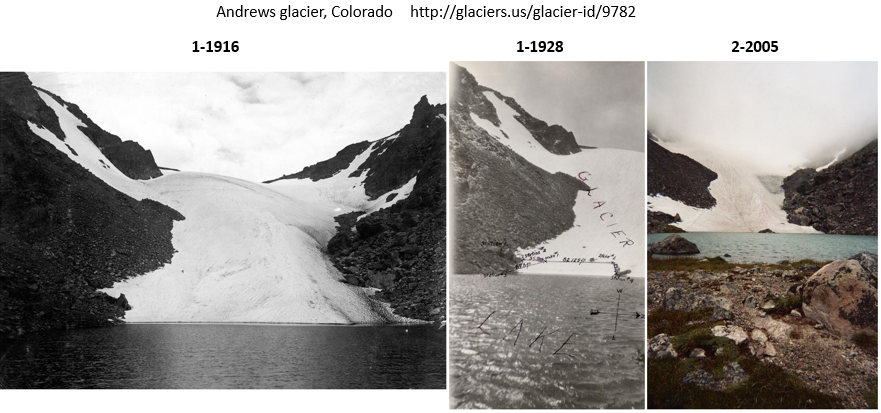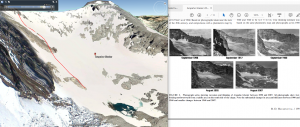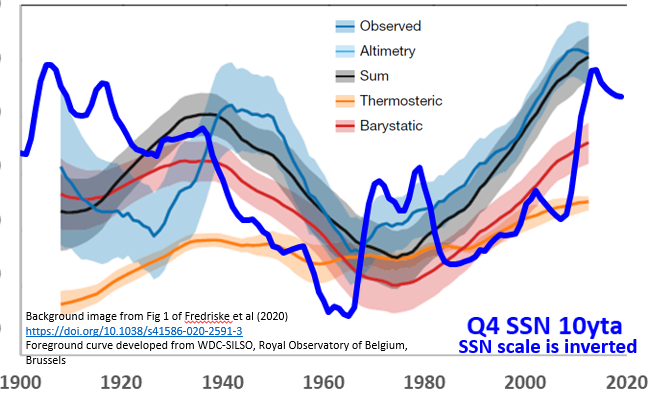
Three snapshots of the Andrews Glacier in Colorado over a 90 year period
The Denver Post reported a grim future for Colorado’s glaciers [1]. The leading paragraph of that 2018 story notes
“As warmer temperatures creep up higher in altitude, Colorado’s 14 glaciers are melting faster and faster. Glaciers that once stored key water reserves for cities and high-mountain ecology will likely be gone within the next few decades, according to researchers from the Institute of Arctic and Alpine Research (INSTAAR)”
The article relied upon information from Professor Robert Anderson of the University of Colorado and a Fellow at INSTAAR. As noted, the article first claims that glaciers are melting “faster and faster”. Yet later there is mention of a slowdown in ablation in the 2000’s. That was explained by an argument for the Arapaho Glacier, that the “glacier is “retreating into a corner” that is protecting the ice from the sun”
A 2010 study was mentioned but no link or reference was provided. I found it at [3]. I’d like to understand the Arapaho pattern in light of a number of things myself and also to confirm that the glacier retreated into a corner. It’s well known that all of Colorado’s glaciers, flowing down northern by northeastern slopes, are almost always protected from the Sun. So this would be helpful to clear up.
I took a mildly closer look at that 2010 paper and compared some time series pictures from their Figure 2, to a simple Google Earth map coverage for one year later (2011). Several of those photos were for September over various years so I chose that month as well. I did apply that red line trace just to spot check the paper’s notes that this glacier in 1960 was estimated to be only about 0.25 square km in area. The length of the line is about .5 km, so that fits roughly with the 1960 area. The 2007 photo shown at lower right of this image may capture the minima of the glacier over the time span considered. Just a guess for now. I’m not certain why a 2010 report does not include at least a 2009 photo to be as current as feasible.
If I’m then not mistaken, there was a rebound in glacier mass by at least one year after their report date, if not earlier. I also don’t understand why Dr. Anderson in his 2018 interview with the Denver Post did not mention more up to date information than the 2010 paper. Perhaps it might have changed the “faster and faster” notion. I don’t know, and have only done this spot check. But it seems worthy of a question to him at some time. It’s certainly possible that my image on the left only captures an early snowfall. Things like this shouldn’t be difficult to corroborate.
When I reach out, I’ll also ask about the Andrews Glacier which is shown in the featured image set for this post. I obtained those photos from [1], which is a site that archives many interesting glacier photos through Portland State University. As the featured top image set of this post demonstrates, the glacier always reaches the lake, and has a similar areal coverage. The photos start in 1916 and end in 2005. They cover the same season and I think it’s safe to assume we are only viewing a glacier and not extra snow. If anything, the 2005 photo indicates a slightly expanded glacier from 1916.
Finally it is interesting to me that the news article paints a broad brush of all of Colorado’s admittedly tiny glaciers, but the citation only focuses on Arapaho. If I knew of a more comprehensive resource, I’d take further looks and try to report, whether they turn out to be right or not.
This brief post shares some questions about the Arapaho Glacier, as well as the featured nearby Andrews Glacier. Currently I cannot reconcile INSTAAR’s claim that Colorado’s glaciers are shrinking, with the lines of informal examination featured at this post.
References
[1]
Colorado faces a glacier-less future as warmer temps climb to higher altitudes
[2] Featured image set assembled from http://glaciers.us/glacier-id/9782
[3] (2010) Twentieth-century Changes in the Thickness and Extent of Arapaho Glacier, Front Range, Colorado, Arctic, Antarctic, and Alpine Research, 42:2, 198-209, DOI: 10.1657/1938-4246-42.2.198
 8067total visits,3visits today
8067total visits,3visits today


